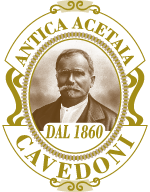The oldest Vinegar Cellar in Castelvetro di Modena
One of the oldest families in the province of Modena that produces Aceto Balsamico Tradizionale Di Modena DOP
Cavedoni acetaia is made up of hundreds of barrels with unique characteristics in the world, in turn divided by the aging of the precious Traditional Balsamic Vinegar of Modena D.O.P. and Balsamic Vinegar of Modena I.G.P.
A characteristic of our barrels is that on the front of them appears the writing marked with fire “fcc”, which stands for Francesco Cavedoni, the person who most of all has been able to promote and believe in the black gold of Modena. He has handed down to us teachings and notions that we jealously guard and pass on to future generations!!
The luck of being born from an ancient experience…
DOP
Italy with its 836 products with Designation of Origin and Geographical Indication is recognized as a unique country in the world for “Excellence”, the D.O.P. Traditional Balsamic Vinegar of Modena is certainly the witness of traditions that have their roots in the mists of time, but also of passions, love for the territory, patience and know how to make Modena.
Guarantee of respect for ancient traditions
Protected Designation of Origin (D.O.P.) means that the production chain of this vinegar takes place absolutely within the territories of the Province of Modena, from grape harvesting to product ageing; it is not only a productive but also a cultural heritage to be known and explored.
Traditional Balsamic Vinegar – The bottle
This bottle, defined as “di Giugiaro”, is the only official bottle for all producers. The product is bottled only after the approval of the expert tasters and only by a bottling centre authorised specifically by MIPAAF and subjected to chain checks. When the bottle is closed with the special numbered seal, it is the only true guarantee of authenticity and quality.
Harvesting and pressing
The grapes that can be used are Lambrusco (all varieties and clones), Trebbiano (all varieties and clones), Ancellotta, Sauvignon, Sgavetta, Berzemino, Occhio di Gatta, and also the grapes of the vineyards included in the DOC but, all and in any case, produced and harvested in the province of Modena.
Harvesting and crushing: the vineyard is taken care of so that the production is at most 16 Ton/ ha (hectare) of grapes, much more limited than the quantities allowed for local DOCG wines, 22 Ton/ ha; the grapes are usually harvested by hand in order to better choose the bunches but also because the harvest time allows, time by time, theimmediate cooking of the fresh must before spontaneous fermentation begins.
The choice of the degree of ripeness in the harvest or of any percentage of the grapes in the must is at the discretion of the producer. The soft pressing allows to obtain a “flower” must, sweet and fragrant and with low content of tannins.
Cooking of the must
The must is cooked in open-air boilers (therefore at room pressure) and in direct fire, at temperatures that can vary between 95 and 70 degrees, as the sugar concentration of the must increases by evaporation. The times of this slow cooking can sometimes exceed twelve hours and are at the discretion of the producer depending on the harvest and the needs of the individual batteries.
Fermentation and acetification
The cooked must is allowed to cool and decant and then fermented by the yeast and ferments naturally selected in the single acetaia. The fermented cooked must is then used to feed the “mother barrels”, where the alcohol produced by fermentation is slowly transformed by Acetobacter into acetic acid, leading to the production of basic vinegar, that for progressive and patient concentration in the battery originates the inimitable organoleptic complexity of Traditional Balsamic Vinegar of Modena.
Maturation and aging
These last and characteristic phases take place in the real production unit that is the “battery“. It is a set of barrels with normally decreasing volumes, often of different woods, through which vinegar proceeds over the years thanks to the annual practice of “racking“. This is done annually and usually in the cold season, in order to compensate for shortages due to natural evaporation and withdrawals.
Usually, in the winter period, the smallest cask is brought back to the level with the necessary amount of vinegar taken from the second cask, then the second is brought back to the volume with vinegar taken from the third and so it proceeds until the last barrel of the battery that in turn is “warm up” with the basic vinegar taken from the mother barrels. The process proceeds annually, wisely governed by the individual producer, who performs and carefully follows all the operations that support the battery in its slow maturation, and only after at least 12 long years you can take from the last cask, the smallest, an annual rate of finished product.
Continuing with this procedure, year after year the quality and organoleptic complexity of the vinegar tends to improve until it can boast of the denomination “Extravecchio” after at least 25 years of continuous and wise care by the producer. It is therefore a process “in continuous” with a synchronous balance between the quantities of collection and those of transfer and refill so that the complexity of chemical physical transformations that are slowly realized in that unique and inimitable laboratory represented by the battery, take over time the product to achieve the correct smooth syrup, the harmonious balance of the sweet and sour component and the rich bouquet of scents and flavors that identifies theTraditional Balsamic Vinegar Of Modena.
It is therefore to be specified that the batteries, if properly managed, can aspire to reach increasingly high quality levels following quantities of annual collection appropriately limited at the discretion of the manufacturer.
Sale and preparation of 5-7-9 barrels with calastra (support).
Sale must cooked per liter.
